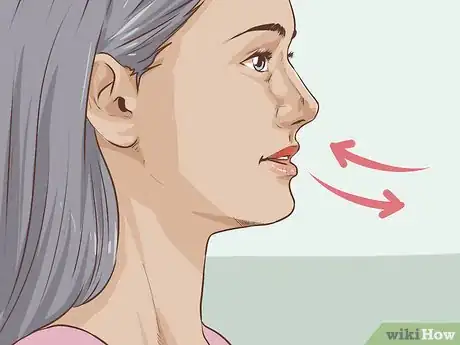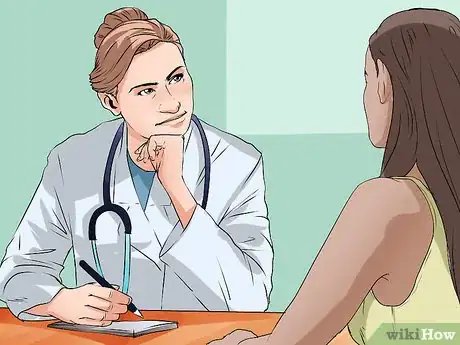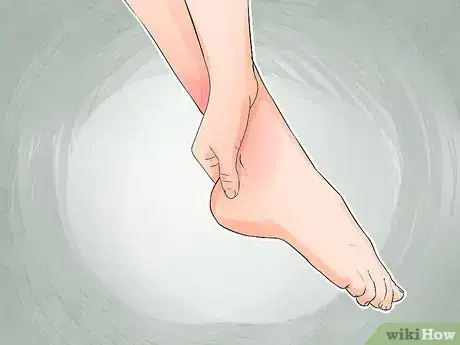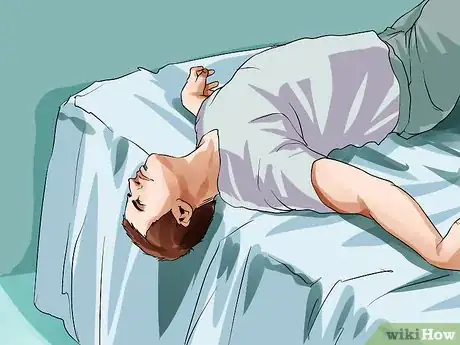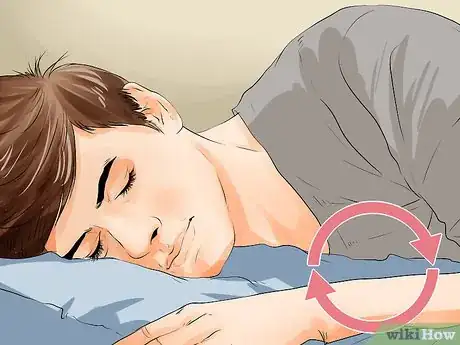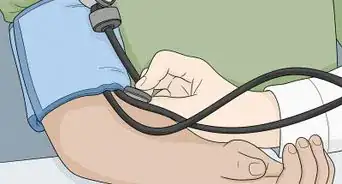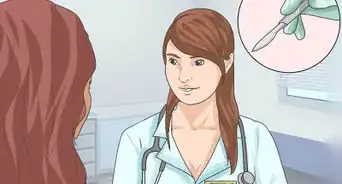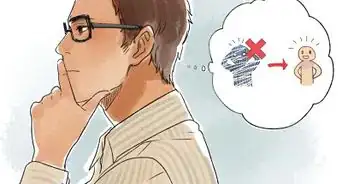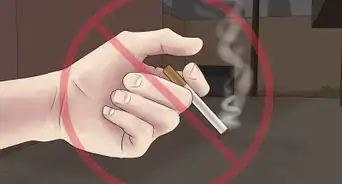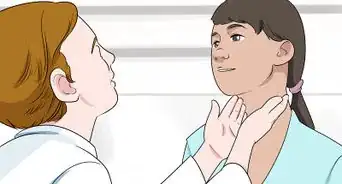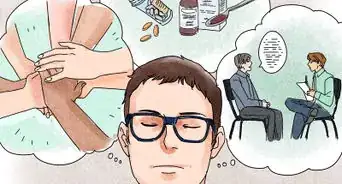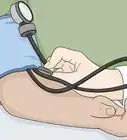This article was co-authored by Marc Kayem, MD. Dr. Marc Kayem is a board certified Otolaryngologist and Facial Plastic Surgeon based in Beverly Hills, California. He practices and specializes in cosmetic services and sleep-related disorders. He received his Doctorate in Medicine from the University of Ottawa, is board certified by the American Board of Otolaryngology, and is a Fellow of the Royal College of Surgeons of Canada.
This article has been viewed 26,507 times.
Twitching, which is a sudden, involuntary movement that can occur at any time, even in a deep sleep, can disrupt your sleep and reduce your overall health and well-being. There are many different causes of nighttime twitching, many of which are treatable. While some causes may require medical treatment, you can often stop or reduce twitching with basic lifestyle adjustments. For instance, relaxing before bed, exercising, and eating a balanced diet can all help fight twitching.[1]
Steps
Relaxing Before Bed
-
1Meditate.[2] Listen to a guided meditation right before bed. Videos and recordings are freely available online, and you don’t need to do any research about meditation to begin using this relaxation technique. The benefits of meditation revolve around the practice’s ability to distract you from thoughts and feelings that may be causing you physical turmoil, even while you sleep.[3]
- Guided meditations will give your clear, simple instructions that are easy to follow.
- When choosing a guided meditation, be sure to choose a video or recording with a voice and pace that you enjoy. It’s best to choose a video earlier in the day and save it for use later.
-
2Focus on your breath. One particularly effective meditation technique involves practicing mindfulness. To do so, simply focus your attention entirely on one thing, such as your breath. For instance, think about how it feels as air enters and exits your body. It may also help to repeat the same thought with each breath. For instance, simply think the word “relax” each time your exhale.[4]
- Mindfulness has consistently been proven to help increase both the quality and the duration of people’s sleep, and to decrease the number of disturbances people experience while sleeping. In fact, mindfulness has been proven equally as effective as some medications in treating sleep-related conditions.[5]
- When thoughts arise that momentarily distract you, simply push them away. Do not contemplate why you are thinking certain things, or become angry with yourself. Simply let the thought go and return your focus to whatever you’d been meditating on.
Advertisement -
3Try progressive muscle relaxation. This is both a physical and mental exercise that can help calm both your body and mind. By focusing on specific muscles, you draw your mind away from stress, and wind up relaxing your muscles in the process. Do the exercise right before or after climbing into bed, and whatever position you feel most comfortable.[6]
- Before you begin, take a minute to focus on your breath. Breathe deeply and slowly.
- After a deep inhale, flex the muscles of your toes and feet and count to four. Exhale slowly and allows your muscles to relax.
- Repeat the process for your different muscle groups, moving up your body. For instance, after the next inhalation, flex the muscles in your lower legs.
- Continue to your upper legs, abdomen and lower back, chest and upper back, fingers and hands, lower arms, upper arms, and shoulders and neck.
- Finally, after another deep inhalation, flex the muscles of your face. You will likely have to make a funny face to do so.
- On the final inhalation of a complete cycle, tense all of the muscles in your body. After holding the tension for a count of four, release this tension as you slowly exhale.
- Repeat the entire process three times through.
- As with many relaxation exercises, you can find free videos and recordings online that will guide you through progressive muscles relaxation.
-
4Do deep breathing exercises. Many meditation and other relaxation exercises benefit from deep breathing. In fact, deep breathing alone can relax your muscles, slow your heart rate, reduce anxiety, and diminish disturbing thoughts. There are two main factors to be mindful of while learning to breathe more deeply. First, breathe all the way into your abdomen. Second, maintain a slow and steady breathing rate.[7]
- More specifically, start by closing your eyes and focusing your attention on your breath. Place one hand on your lower belly, and the other on your upper chest.
- Inhale through your nose for five seconds, trying to bring your breath as deep into your body as possible. Your goal is making the hand on your belly rise, while the hand on your chest only moves a bit. While this may be challenging, you can quickly improve your ability to do so with practice.
- After inhaling, hold your breath for five seconds, and exhale for five seconds. Repeat this breathing practice for five minutes.
- Even better, do this breathing practice lying in bed as you wait to fall asleep. Not only will it help you do so, it will help your body and mind calm down as they drift off the sleep.
- Find a free video online to help guide you through a few deep breathing exercises if you’re just learning. Many include visual reminders to help you keep a steady pace, for instance.
Determining What’s Causing You to Twitch
-
1
-
2Do a sleep study. You physician may recommend a sleep study. You may even want to ask about whether or not doing so, even if they don’t bring it up. Medical professionals will monitor your body and brain activity as you sleep, which will help them determine the cause of your twitching.[10]
-
3Consider whether you may be experiencing sleep tremors. It can be hard to describe what nighttime twitches feel like, let alone diagnose their cause. To help you do so, it can be helpful to weigh the likelihood of different causes.[11]
- Does the twitching most commonly occur in your hands, arms, legs, and face? If so, you may be experiencing sleep tremors. Talk to your doctor to ensure you do not have a neurological disorder. Meanwhile, reduce your alcohol consumption, as drinking is another common cause of sleep tremors.
-
4Monitor when twitching occurs. Another likely type of twitching you may be experiencing is actually a condition called sleep myoclonus. These types of twitches can appear repeatedly or singularly. Their distinguishing factor is that they occur during the initial stages of sleep. Though these types of twitches are very common, it’s important to mention them to your doctor.[12]
- Since the timing of your twitches matter, get in the habit of writing down the time whenever a twitch prevents you from falling asleep or wakes you up. Share this information with your doctor.
- Twitching of this sort may indicate restless legs syndrome or other sleep issues that can prevent you from getting quality rest.
-
5Identify a sleep convulsion. You may also be experiencing convulsions. If involuntary spasms afflict one or two limbs in particular and last for a minute or two, it is likely a convulsion. Note which limbs are affected, as well as any changes in consciousness, as well as your temperature.[13]
- Convulsions may be a symptom of a serious health condition, including a head injury, heart disease, epilepsy, or low blood sugar.
-
6Seek help for dystonia. Dystonia is a movement disorder in which your muscles contract uncontrollably. It requires medical treatment to control. Some early symptoms to watch for include:[14]
- Speech problems
- Uncontrollable blinking
- Pulling sensation in your neck
- Foot cramps
- Dragging your leg
-
7Rule out REM behavior disorder. If you’re twitching during REM sleep, you are less likely to notice, though you may actually be twitching quite aggressively. This occurs when your muscles have muscle spasms, reacting and twitching in an attempt to keep up with your dreams.[15]
- If you find yourself waking in the middle of night, or a partner tells you you’ve been twitching heavily at night, talk to your doctor about REM behavior disorder.
Maintaining a Healthy Lifestyle
-
1Exercise every day. One of the best ways to reduce nighttime twitching is by staying active. Exercise not only makes your body healthier, it reduces anxiety and helps you fall asleep more quickly as well Even if only for a jog around the block, get in the habit of exercising moderately for at least 30-45 minutes every day.[16]
- Other good exercise options include bicycling to work or going for a swim.
-
2Keep a consistent bedtime routine. Another helpful methods to get higher quality sleep is keeping a regular bedtime routine. Most importantly, try to go to bed at the same time every night. Further, do the same sequence of activities before going to sleep each night.[17]
- For instance, do a relaxing yoga routine, take a warm shower, and read for fifteen minutes before lights out every night.
-
3Eat plenty of magnesium. One of the nutrients that it most important to a good night’s rest is magnesium. The best way to make sure you’re getting enough is by eating foods rich in magnesium. These include nuts and seeds, legumes, and green vegetables.[18]
-
4Adjust what you consume before bed. There are several things that people commonly consume that may be contributing to your nighttime twitching.[19] The most likely culprits are medication, alcohol, or caffeine.[20]
- If you can, take medications earlier in the day.
- Keep alcohol consumption to one drink per day for females and two per day for males.
-
5Stay hydrated. Another way to immediately improve your general health and likely reduce twitches at night is drinking more water. Shoot for eight 8-ounce cups of water per day. Additionally, limit your consumption of alcohol, caffeine, and soda, as these beverages will actually dehydrate you.[21]
-
6Address potential vitamin deficiencies. A balanced diet is important to all aspects of your health, including sleeping. Other important minerals to ensuring a good night’s rest include folate, zinc, calcium, and iron. If your diet does not contain adequate amounts of these nutrients, talk to your doctor about taking nutritional supplements. This alone may reduce twitching symptoms.[22]
References
- ↑ http://www.newkidscenter.com/Twitching-in-Sleep.html
- ↑ Marc Kayem, MD. Sleep Specialist. Expert Interview. 24 October 2019.
- ↑ http://www.nosleeplessnights.com/sleep-hygiene/relaxation-techniques/
- ↑ http://www.nosleeplessnights.com/mindfulness-exercises/
- ↑ http://www.nosleeplessnights.com/mindfulness-exercises/
- ↑ http://www.nosleeplessnights.com/sleep-hygiene/relaxation-techniques/
- ↑ http://www.nosleeplessnights.com/sleep-hygiene/relaxation-techniques/
- ↑ Marc Kayem, MD. Sleep Specialist. Expert Interview. 24 October 2019.
- ↑ http://www.newkidscenter.com/Twitching-in-Sleep.html
- ↑ http://www.newkidscenter.com/Twitching-in-Sleep.html
- ↑ http://www.newkidscenter.com/Twitching-in-Sleep.html
- ↑ https://www.sleepassociation.org/patients-general-public/sleep-myoclonus/
- ↑ http://www.newkidscenter.com/Twitching-in-Sleep.html
- ↑ http://www.webmd.com/brain/dystonia-causes-types-symptoms-and-treatments#1
- ↑ http://www.newkidscenter.com/Twitching-in-Sleep.html
- ↑ http://www.newkidscenter.com/Twitching-in-Sleep.html
- ↑ http://www.newkidscenter.com/Twitching-in-Sleep.html
- ↑ http://www.newkidscenter.com/Twitching-in-Sleep.html
- ↑ http://www.newkidscenter.com/Twitching-in-Sleep.html
- ↑ Marc Kayem, MD. Sleep Specialist. Expert Interview. 24 October 2019.
- ↑ http://www.newkidscenter.com/Twitching-in-Sleep.html
- ↑ http://www.newkidscenter.com/Twitching-in-Sleep.html


